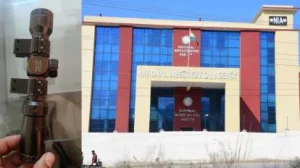In a recent class on Trigonometry held for candidates preparing for the National Defence Academy and Naval Academy (NDA-NA) Exam – Paper I (Maths), the focus was on two advanced and essential topics: Trigonometric Equations and Inverse Trigonometric Functions (ITF). Both topics hold significant weight in the NDA-NA exam, and mastering them is key for anyone looking to score well.
In this blog, we will explore what was discussed in the class, strategies for preparation, and how to effectively approach these topics in the exam.
Class Overview: Trigonometric Equations and Inverse Trigonometric Functions
The class began by tackling the complex yet intriguing world of Trigonometric Equations, followed by a deep dive into Inverse Trigonometric Functions (ITF) and the various formulas associated with them. Below is a breakdown of the topics covered:
1. Trigonometric Equations
Trigonometric equations involve finding the angles (solutions) that satisfy given trigonometric expressions. These equations can vary in complexity, from basic ones involving single angles to more complicated forms involving multiple terms or angles. The class highlighted different approaches to solving these equations, focusing on how to manipulate and simplify them to find solutions.
The instructor discussed how trigonometric equations can have multiple solutions due to the periodic nature of trigonometric functions. Understanding the behavior of these functions and their repetitive cycles is crucial for identifying all possible solutions. The class emphasized common types of equations likely to appear in the NDA-NA exam and how to approach them step by step.
2. Inverse Trigonometric Functions (ITF)
Inverse Trigonometric Functions (ITF) allow us to find the angle that corresponds to a particular trigonometric value. These functions reverse the roles of the standard trigonometric ratios, providing the angle as the result.
In the class, a key part of the discussion was on domain and range restrictions for ITF, which are critical in solving problems accurately. The domain and range for inverse functions are narrower compared to their regular counterparts, and the instructor took time to explain why this restriction exists and how to work within it.
3. Formulas Associated with ITF
Formulas play a major role in solving problems involving ITF. The class covered several key formulas that are often used to simplify or transform expressions in inverse trigonometric problems. These formulas allow you to connect inverse functions with their regular trigonometric counterparts, aiding in solving more complex problems.
The instructor guided students through examples where these formulas were applied, showing how they can be used to break down challenging problems into manageable steps. Students were encouraged to practice these formulas extensively, as they are likely to appear in various forms in the NDA-NA exam.
Strategies to Prepare for Trigonometric Equations and ITF for the NDA-NA Exam
The class emphasized the importance of strategic preparation for these topics, as they require both conceptual understanding and practical problem-solving skills. Here are some essential strategies to help you prepare:
1. Understand the Behavior of Trigonometric Functions
Trigonometric equations can be tricky because trigonometric functions are periodic, meaning they repeat their values over certain intervals. To solve equations involving sine, cosine, or tangent, it is crucial to understand their periodic nature and how their graphs behave.
Spend time studying the graphical representation of trigonometric functions. This will help you visualize how solutions to trigonometric equations are distributed across different intervals, and it will also help you quickly identify the correct solutions in a timed exam setting.
2. Memorize Key ITF Formulas
Inverse Trigonometric Functions (ITF) require a set of specific formulas to solve problems efficiently. Make sure to compile and memorize these formulas, including those that relate inverse functions to standard trigonometric identities.
However, simply memorizing the formulas is not enough—you must also practice applying them to various types of questions. Be sure to work through problems that require different combinations of ITF formulas, as this will strengthen your ability to recall and use them quickly.
3. Practice Past Exam Questions
One of the most effective ways to prepare for the NDA-NA exam is by solving previous years’ question papers. The class incorporated a lot of discussion around MCQs from past NDA-NA exams, showing how often trigonometric equations and ITF appear in various forms.
By practicing these questions, you’ll gain an understanding of the specific types of problems that are commonly tested. Focus on timing yourself while solving these papers to simulate exam conditions. The more familiar you are with the format and complexity of the questions, the better prepared you’ll be for the actual exam.
4. Work on Time Management
Trigonometric problems can be time-consuming if not approached strategically. As you solve these problems, work on identifying the shortest path to the solution. This could mean recognizing when to apply certain ITF formulas or knowing when to simplify a trigonometric equation before solving it.
The class highlighted several time-saving techniques, such as looking for symmetries in equations or utilizing inverse function properties to simplify expressions quickly. Incorporate these techniques into your study routine so that you can save valuable time during the exam.
5. Focus on Conceptual Understanding
Trigonometric equations and ITF problems often involve more than just plugging numbers into formulas. Many questions will test your conceptual understanding of how trigonometric functions behave, how their inverses work, and how various identities interact with each other.
To strengthen your conceptual understanding, work through example problems that require you to apply multiple concepts simultaneously. This will help you build the intuition needed to tackle complex problems with confidence.
Conclusion: Mastering Trigonometric Equations and ITF for NDA-NA Exam Success
Trigonometry is a core topic in the NDA-NA exam, and understanding both Trigonometric Equations and Inverse Trigonometric Functions (ITF) is essential for success. The recent class provided a solid foundation in these areas by covering key concepts, formulas, and solving strategies that are critical for exam preparation.
As you prepare for the NDA-NA exam, remember to focus on understanding the behavior of trigonometric functions, memorize and practice key ITF formulas, and continually solve past exam questions to build your confidence and speed. Time management, conceptual clarity, and consistent practice are the three pillars that will help you excel in trigonometry.
By mastering these topics, you will not only be better equipped for the exam but also build a strong mathematical foundation that will serve you well in your future studies and career in defense.
Good luck with your preparation!



















